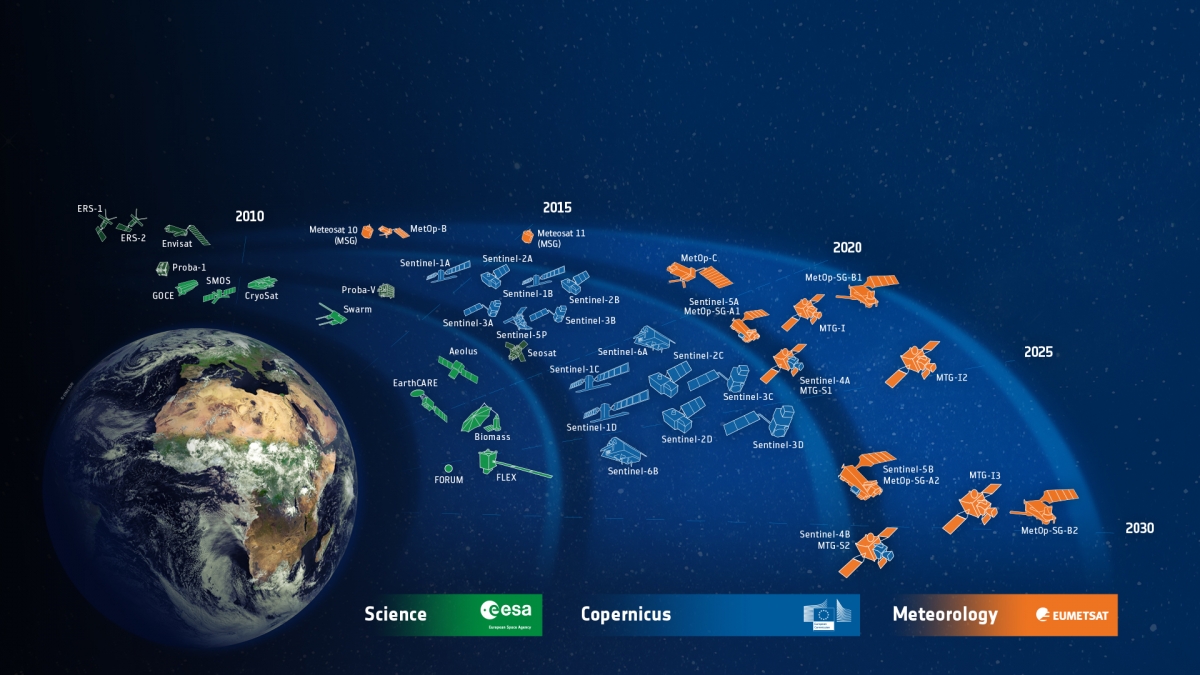
The European Space Agency (ESA) is an intergovernmental organisation of 22 member states dedicated to space activities and with an annual budget of over 5 billion €. It was established in 1975 and Belgium was one of its founding members. ESA acts as the de facto Belgian space agency.
Its activities include human spaceflight, space transportation, navigation, space science, space engineering and technologies, operations, telecommunications, integrated applications and Earth Observation.
Within the domain of Earth Observation, ESA has different programmes, each with their own specificities:
EOEP
The Earth Observation Envelop Programme (EOEP) is the backbone of the scientific and research activities of ESA in the field of Earth observation. It consists of 2 main elements, namely:
Research Mission Component
Formerly named Earth Explorer Component, it includes the definition, development and launch of the ‘Research Missions’. These space missions try to provide an answer to pressing questions about our 'living planet'. They are developed on the edge of what is technically feasible.
There are currently (2018) 8 Research missions:
- GOCE: gravity mission;
- SMOS: water mission;
- CRYOSAT: ice mission;
- SWARM: magnetic field mission;
- ADM-Aeolus: wind mission;
- EARTHCARE: cloud and aerosol mission;
- BIOMASS: forest mission (under development)
- FLEX: fluorescence and plant health mission (under development).
Development and Exploitation Component
It includes:
- Preparatory activities and Instrument Pre-Development and even definition activities for different types of new missions;
- Management ofthe Research missions;
- Scientific exploitation and developments of novel applications and pre-commercial services.
Earth Watch
This programme comprises activities with a more operational nature, called 'Programme elements'.
Climate Change Initiative (CCI)
Over the last 30 years ESA and its Member States built up long-term Earth observation archives. With this data, ESA is able to make a significant contribution to the climate change research.
Incubed
A programme element for new commercial space technologies.
PROBA-V exploitation
This programme element includes the mission planning and operations of the PROBA-V satellite, its instrument and the ground segment, as well as the production and -archiving of the various VEGETATION-products.
ALTIUS
This programme element includes the development and the launch of a limb sounder satellite mission, called ALTIUS, based on a PROBA platform, which will monitor the 3D distribution and the evolution of stratospheric ozone with a high vertical resolution.
Copernicus Space Component
The Copernicus Space Component Programme(CSC) (formerly GMES Space Component) provides the development and construction of dedicated operational Earth observation satellites or instruments for the EU programme Copernicus. The mission concept of the CSC are the Sentinel satellites and instruments. They are divided into different families that each generates specific Eearth observation data. These data support the Copernicus information services within the EU programme and have to generate opportunities for the commercial market.
Meteorological programmes
These programmes are a fruitful cooperation between ESA and EUMETSAT.
METOP SG
MetOp Second Generation (MetOp-SG) is an ESA programme that provides the development of 2 prototype polar-orbiting meteorological satellites, MetOp-SG-A and MetOp-SG-B, for the EUMETSAT Polar System SG (EPS-SG). The complete system, constituted by 3 satellites of both types should be operational from 2021 to 2043.
MTG
The ESA MTG (METEOSAT Third Generation) programme provides the development of 2 prototype geostationary satellites for the MTG system of EUMETSAT: an imager (MTG-I) and a sounder (MTG-S). The complete system will count a total of 6 satellites, 2 MTG-S and 4 MTG-I. These satellites will ensure the continuity of the operational meteorological observations from space. The MTG system should be operational for more than 20 years until after 2040. The launches of the first satellites are planned for 2021 (MTG-I) and in 2023 (MTG-S). The MTG-S will also embark the Copernicus instrument, Sentinel 4.
